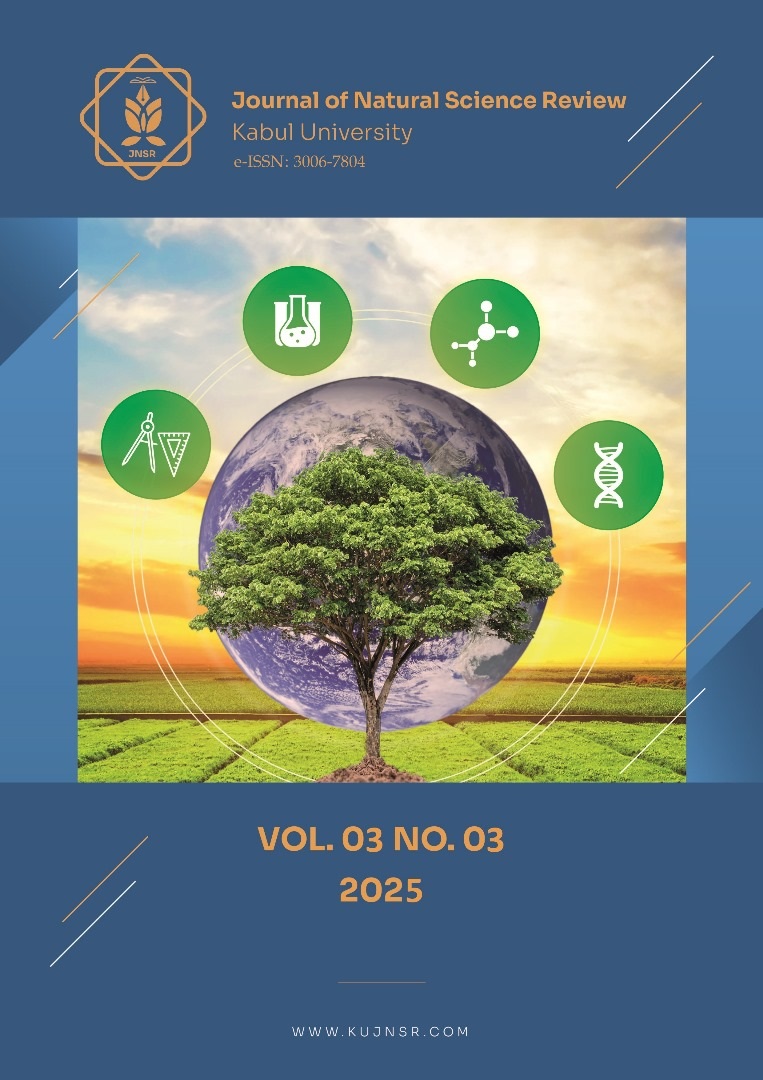Principles and Requirements of Battery Electrolytes: Ensuring Efficiency and Safety in Energy Storage
DOI:
https://doi.org/10.62810/jnsr.v3i3.264Keywords:
Battery performance, Electrolyte, Electrochemical stability, Energy storage, Ionic conductivity, Solid-state electrolytes.Abstract
Electrolytes lie at the heart of every battery, serving as the medium that allows ions to move between electrodes and enabling energy to be stored and released efficiently. Their properties, such as ionic conductivity, electrochemical stability, and thermal resilience, directly shape the performance, safety, and lifespan of energy storage systems. As demand for reliable batteries grows in electric vehicles, renewable energy integration, and portable devices, the design of better electrolytes has become a critical research priority. This review brings together insights from a wide range of studies to examine the principles, requirements, and limitations of five major electrolyte systems: aqueous, organic, ionic liquid, solid-state, and redox-active types. Each category demonstrates clear strengths but also important trade-offs. Aqueous electrolytes remain affordable and eco-friendly yet struggle with narrow voltage windows. Organic systems deliver high energy density but introduce flammability concerns. Ionic liquids promise exceptional stability but remain expensive and viscous. Solid-state electrolytes enhance safety and energy density, though they face manufacturing and conductivity challenges. Redox-active systems stand out for durability and scalability, particularly in grid-level applications, but lack compactness. Taken together, the findings emphasize that no single solution is universal. Instead, electrolyte design must be tailored to the context, balancing performance, safety, cost, and sustainability.
Downloads
References
Albertus, P., Anandan, V., Ban, C., Balsara, N., Belharouak, I., & Buettner-Garrett. (2021). Challenges for and Pathways toward Li-Metal-Based All-Solid-State Batteries. ACS Energy Letters, 6(4), 1399–1404. https://doi.org/10.1021/acsenergylett.1c00445 DOI: https://doi.org/10.1021/acsenergylett.1c00445
Armand, M., Endres, F., MacFarlane, D. R., Ohno, H., & Scrosati, B. (2009). Ionic-liquid materials for the electrochemical challenges of the future. Nature Materials, 8(8), 621–629. https://doi.org/10.1038/nmat2448 DOI: https://doi.org/10.1038/nmat2448
Armand, M., & Tarascon, J. M. (2008). Building Better Batteries. Nature, 451(7179), 652. https://doi.org/10.1038/451652a DOI: https://doi.org/10.1038/451652a
Balbuena, P. B. (2014). Electrolyte materials - Issues and challenges. AIP Conference Proceedings, 1597, 82–97. https://doi.org/10.1063/1.4878481 DOI: https://doi.org/10.1063/1.4878481
Borodin, O., Ren, X., Vatamanu, J., Von Wald Cresce, A., Knap, J., & Xu, K. (2017). Modeling Insight into Battery Electrolyte Electrochemical Stability and Interfacial Structure. Accounts of Chemical Research, 50(12), 2886–2894. https://doi.org/10.1021/acs.accounts.7b00486 DOI: https://doi.org/10.1021/acs.accounts.7b00486
Boz, B., Dev, T., Salvadori, A., & Schaefer, J. L. (2021). Review—Electrolyte and Electrode Designs for Enhanced Ion Transport Properties to Enable High-Performance Lithium Batteries. Journal of The Electrochemical Society, 168(9), 090501. https://doi.org/10.1149/1945-7111/ac1cc3 DOI: https://doi.org/10.1149/1945-7111/ac1cc3
Chattopadhyay, J., Pathak, T. S., & Santos, D. M. F. (2023). Applications of Polymer Electrolytes in Lithium-Ion Batteries: A Review. Polymers, 15(19). https://doi.org/10.3390/polym15193907 DOI: https://doi.org/10.3390/polym15193907
chen, li, Mullen, G., Roch, M., Cassity, C., Gouault, N., Fadamiro, H., Barletta, R., O’Brien, R., Sykora, R., Stenson, A., West, K., Horne, H., Hendrich, J., Xiang, K., & Davis, J. (2014). On the Formation of a Protic Ionic Liquid in Nature. Angewandte Chemie International Edition, 53. https://doi.org/10.1002/anie.201404402 DOI: https://doi.org/10.1002/anie.201404402
Chen, R., Bresser, D., Saraf, M., Gerlach, P., Balducci, A., Kunz, S., Schröder, D., Passerini, S., & Chen, J. (2020). A Comparative Review of Electrolytes for Organic-Material-Based Energy-Storage Devices Employing Solid Electrodes and Redox Fluids. ChemSusChem, 13(9), 2205–2219. https://doi.org/10.1002/cssc.201903382 DOI: https://doi.org/10.1002/cssc.201903382
Chen, S., Zhang, M., Zou, P., Sun, B., & Tao, S. (2022). Historical development and novel concepts on electrolytes for aqueous rechargeable batteries. Energy and Environmental Science, 1805–1839. https://doi.org/10.1039/d2ee00004k DOI: https://doi.org/10.1039/D2EE00004K
Chennupati Jagadish,Robert Hull, R. M. O. (2020). Handbook of Nanocomposite Supercapacitor Materials I Characteristics (Kamal K. Kar (ed.)). Springer Series in Materials Science. https://doi.org/https://doi.org/10.1007/978-3-030-43009-2 DOI: https://doi.org/10.1007/978-3-030-43009-2
Feng, R., Guo, Z., Meng, X., & Sun, C. (2025). Modeling and State of Charge Estimation of Vanadium Redox Flow Batteries: A Review. Energies, 18(17). https://doi.org/10.3390/en18174666 DOI: https://doi.org/10.3390/en18174666
Francisco, B. E., Jones, C. M., Lee, S. H., & Stoldt, C. R. (2012). Nanostructured all-solid-state supercapacitor based on Li 2S-P 2S 5 glass-ceramic electrolyte. Applied Physics Letters, 100(10), 1–6. https://doi.org/10.1063/1.3693521 DOI: https://doi.org/10.1063/1.3693521
Hamed, M. M., El-Tayeb, A., Moukhtar, I., El Dein, A. Z., & Abdelhameed, E. H. (2022). A review on recent key technologies of lithium-ion battery thermal management: External cooling systems. Results in Engineering, 16, 100703. https://doi.org/10.1016/J.RINENG.2022.100703 DOI: https://doi.org/10.1016/j.rineng.2022.100703
Howarth, A. J., Liu, Y., Li, P., Li, Z., Wang, T. C., Hupp, J. T., & Farha, O. K. (2016). Chemical, thermal and mechanical stabilities of metal–organic frameworks. Nature Reviews Materials, 1(3), 15018. https://doi.org/10.1038/natrevmats.2015.18 DOI: https://doi.org/10.1038/natrevmats.2015.18
Hua, Y., Zhou, S., Huang, Y., Liu, X., Ling, H., Zhou, X., Zhang, C., & Yang, S. (2020). Sustainable value chain of retired lithium-ion batteries for electric vehicles. Journal of Power Sources, 478, 228753. https://doi.org/10.1016/J.JPOWSOUR.2020.228753 DOI: https://doi.org/10.1016/j.jpowsour.2020.228753
Il’ina, E. A., Antonov, B. D., & Vlasov, M. I. (2020). Stability investigations of composite solid electrolytes based on Li7La3Zr2O12 in contact with LiCoO2. Solid State Ionics, 356, 115452. https://doi.org/10.1016/J.SSI.2020.115452 DOI: https://doi.org/10.1016/j.ssi.2020.115452
Janek, J., & Zeier, W. G. (2016). A solid future for battery development. Nature Energy, 1(9), 16141. https://doi.org/10.1038/nenergy.2016.141 DOI: https://doi.org/10.1038/nenergy.2016.141
Joia, R., Modaqeq, T & Mohammadi, M. H. (2024). Principles and Requirements of Battery Membranes : Ensuring Efficiency and Safety in Energy Storage. European Journal of Theoretical and Applied Sciences, 2(2), 493–505. https://doi.org/10.59324/ejtas.2024.2(2).42 DOI: https://doi.org/10.59324/ejtas.2024.2(2).42
Karabelli Kaus, D., Birke, K., & Weeber, M. (2021). A Performance and Cost Overview of Selected Solid-State Electrolytes: Race between Polymer Electrolytes and Inorganic Sulfide Electrolytes. Batteries, 7, 18. https://doi.org/10.3390/batteries7010018 DOI: https://doi.org/10.3390/batteries7010018
Khan, M. (2015). 美国科学院学报 Materials Chemistry A 材料化学 a. Journal of Materials Chemistry A, 6(207890), 121.
Lee, H., Yoon, T., & Chae, O. B. (2024). Strategies for Enhancing the Stability of Lithium Metal Anodes in Solid-State Electrolytes. Micromachines, 15(4). https://doi.org/10.3390/mi15040453 DOI: https://doi.org/10.3390/mi15040453
Li, Q., Chen, J., Fan, L., Kong, X., & Lu, Y. (2016). Progress in electrolytes for rechargeable Li-based batteries and beyond. Green Energy and Environment, 1(1), 18–42. https://doi.org/10.1016/j.gee.2016.04.006 DOI: https://doi.org/10.1016/j.gee.2016.04.006
Ma, M., Zhang, M., Jiang, B., Du, Y., Hu, B., & Sun, C. (2023). A review of all-solid-state electrolytes for lithium batteries: high-voltage cathode materials, solid-state electrolytes and electrode-electrolyte interfaces. Materials Chemistry Frontiers, 7(7), 1268–1297. https://doi.org/10.1039/d2qm01071b DOI: https://doi.org/10.1039/D2QM01071B
Miao, Y., Liu, L., Zhang, Y., Tan, Q., & Li, J. (2022). An overview of global power lithium-ion batteries and associated critical metal recycling. Journal of Hazardous Materials, 425. https://doi.org/10.1016/j.jhazmat.2021.127900 DOI: https://doi.org/10.1016/j.jhazmat.2021.127900
Moradi, Z., Lanjan, A., Tyagi, R., & Srinivasan, S. (2023). Review on current state, challenges, and potential solutions in solid-state batteries research. Journal of Energy Storage, 73, 109048. https://doi.org/10.1016/J.EST.2023.109048 DOI: https://doi.org/10.1016/j.est.2023.109048
Nagarajan, S., Hwang, S., Jaye, C., Weiland, C., Meira, D. M., Balasubramanian, M., & Arava, L. M. R. (2025). Investigation of electrode-electrolyte interfaces to enable non-flammable Li-ion batteries operating up to 125°C with liquid electrolyte. Cell Reports Physical Science, 6(5), 102597. https://doi.org/10.1016/J.XCRP.2025.102597 DOI: https://doi.org/10.1016/j.xcrp.2025.102597
Ramachandran, R., & Wang, F. (2018). Electrochemical Capacitor Performance: Influence of Aqueous Electrolytes. Supercapacitors - Theoretical and Practical Solutions. https://doi.org/10.5772/intechopen.70694 DOI: https://doi.org/10.5772/intechopen.70694
Rao, Y., Li, X., Zhao, S., Liu, P., Wu, F., Liu, X., Zhou, N., Fang, S., & Passerini, S. (2024). Fluorinated electrolyte formulations design enabling high-voltage and long-life lithium metal batteries. Nano Energy, 123, 109362. https://doi.org/https://doi.org/10.1016/j.nanoen.2024.109362 DOI: https://doi.org/10.1016/j.nanoen.2024.109362
Shah, R., Mittal, V., & Precilla, A. M. (2024). Challenges and Advancements in All-Solid-State Battery Technology for Electric Vehicles. J, 7(3), 204–217. https://doi.org/10.3390/j7030012 DOI: https://doi.org/10.3390/j7030012
Soloveichik, G. L. (2015). Flow Batteries: Current Status and Trends. Chemical Reviews, 115(20), 11533–11558. https://doi.org/10.1021/cr500720t DOI: https://doi.org/10.1021/cr500720t
Taabodi, M. H., Niknam, T., Sharifhosseini, S. M., Asadi Aghajari, H., & Shojaeiyan, S. (2025). Electrochemical storage systems for renewable energy integration: A comprehensive review of battery technologies and grid-scale applications. Journal of Power Sources, 641, 236832. https://doi.org/10.1016/J.JPOWSOUR.2025.236832 DOI: https://doi.org/10.1016/j.jpowsour.2025.236832
Tron, A., Nosenko, A., & Mun, J. (2022). Thermal stability of active electrode material in contact with solid electrolyte. Journal of the Korean Ceramic Society, 59. https://doi.org/10.1007/s43207-021-00164-y DOI: https://doi.org/10.1007/s43207-021-00164-y
Wang, H., Xiong, X., Hu, H., & Liu, S. (2025). Three-Dimensional-Printed Polymer–Polymer Composite Electrolytes for All-Solid-State Li Metal Batteries. Polymers, 17(17). https://doi.org/10.3390/polym17172369 DOI: https://doi.org/10.3390/polym17172369
Weber, A. Z., Mench, M. M., Meyers, J. P., Ross, P. N., Gostick, J. T., & Liu, Q. (2011). Redox flow batteries: a review. Journal of Applied Electrochemistry, 41(10), 1137–1164. https://doi.org/10.1007/s10800-011-0348-2 DOI: https://doi.org/10.1007/s10800-011-0348-2
Yang, A., Yang, C., Xie, K., Xin, S., Xiong, Z., Li, K., Guo, Y.-G., & You, Y. (2023). Benchmarking the Safety Performance of Organic Electrolytes for Rechargeable Lithium Batteries: A Thermochemical Perspective. ACS Energy Letters, 8(1), 836–843. https://doi.org/10.1021/acsenergylett.2c02683 DOI: https://doi.org/10.1021/acsenergylett.2c02683
Yang, H., & Wu, N. (2022). Ionic conductivity and ion transport mechanisms of solid-state lithium-ion battery electrolytes: A review. Energy Science & Engineering, 10(5), 1643–1671. https://doi.org/https://doi.org/10.1002/ese3.1163 DOI: https://doi.org/10.1002/ese3.1163
Yu, F., Huang, M., Wu, P., Qiu, Z., Fan, L.-Q., Lin, J., & Lin, Y. (2014). A Redox-Mediator-Doped Gel Polymer Electrolyte Applied in Quasi-Solid-State Supercapacitors. Journal of Applied Polymer Science, 131. https://doi.org/10.1002/app.39784 DOI: https://doi.org/10.1002/app.39784
Zhang, H., Liu, X., Li, H., Hasa, I., & Passerini, S. (2021). Challenges and Strategies for High-Energy Aqueous Electrolyte Rechargeable Batteries. Angewandte Chemie (International Ed. in English), 60(2), 598–616. https://doi.org/10.1002/anie.202004433 DOI: https://doi.org/10.1002/anie.202004433
Zheng, F., Kotobuki, M., Song, S., Lai, M. O., & Lu, L. (2018). Review on solid electrolytes for all-solid-state lithium-ion batteries. Journal of Power Sources, 389, 198–213. https://doi.org/10.1016/J.JPOWSOUR.2018.04.022 DOI: https://doi.org/10.1016/j.jpowsour.2018.04.022
Zhong, C., Deng, Y., Hu, W., Sun, D., Han, X., Qiao, J., & Zhang, J. (2016). Electrolytes for electrochemical supercapacitors. In Electrolytes for Electrochemical Supercapacitors. https://doi.org/10.1201/b21497-6 DOI: https://doi.org/10.1201/b21497
Zhou, D., Shanmukaraj, D., Tkacheva, A., Armand, M., & Wang, G. (2019). Polymer Electrolytes for Lithium-Based Batteries: Advances and Prospects. Chem, 5(9), 2326–2352. https://doi.org/10.1016/J.CHEMPR.2019.05.009 DOI: https://doi.org/10.1016/j.chempr.2019.05.009
Downloads
Published
How to Cite
Issue
Section
License
Copyright (c) 2025 Reza Joia, Naseer Mukhlis, meiram atamanov, sayed abdullah hossaini

This work is licensed under a Creative Commons Attribution-NonCommercial 4.0 International License.



























